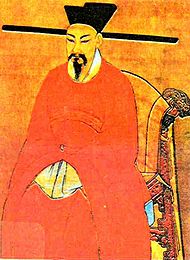- Mongol conquest of the Song Dynasty
-
Mongol conquest of the Song Dynasty 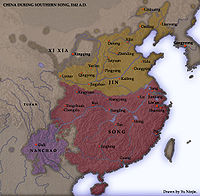
Southern Song before Mongol World conquestsDate 1235-1279 Location South China Result Complete Mongol victory Belligerents The Mongol Empire -
- The Yuan Dynasty
The Song Dynasty Commanders and leaders Ogedei
Tsagaan
Khochu
Toregene
Guyuk Khan
Mongke Khan †
Kublai
Bayan
Aju
Arikhgiya
Zhang HongfanEmperor Lizong of Song
Emperor Duzong of Song
Emperor Gong of Song
Emperor Duanzong of Song
Emperor Huaizong of Song †
Jia Sidao
Lü Wenhuan
Li Tingzhi
Zhang Shijie
Wen TianxiangStrength More than 450,000 (including the Mongols, the Jurchens, the Chinese, the Alans and the Turks) More than 1,500,000 Casualties and losses Very heavy but much fewer than the Song Over 10,000,000 including civilians - Central Asia (Khwarizm)
- Georgia and Armenia
- Volga Bulgaria (Samara Bend
- Bilär)
- Anatolia
- Europe (Dzurdzuketia
- Rus'
- Poland
- Hungary)
- Tibet
- Baghdad
- Korea
- India
- Japan (Bun'ei
- Kōan)
- Vietnam (Bạch Đằng)
- China (Jin
- Song)
- Burma (Ngasaunggyan
- Pagan
- Bhamo)
- Java
- Syria
- Palestine (Ain Jalut)
Mongol conquest of the Song DynastyThe conquest of South China's Song Dynasty under Kublai Khan (r.1260-1294) was the final step for the Mongols to rule the whole of China. It is also considered the Mongol Empire's last great military achievement.[1]
Contents
Background
Before the Mongol-Jin War escalated, an envoy from Song China arrived at the court of the Mongols, perhaps to negotiate a united offensive against the Jin Dynasty (1115–1234). Although Genghis Khan refused, on his death in 1227 he bequeathed a plan to attack the Jin capital by passing through Song territory. Subsequently, a Mongolian ambassador was killed by the Song governor in uncertain circumstances.[2] Before receiving any explanation, the Mongols marched through Song territory to enter the Jin's redoubt in Henan. In 1233 the Song Dynasty finally became an ally of the Mongols, who agreed to share territories south of the Yellow River with the Song. Song general Meng Gong defeated the Jin general Wu Xian and directed his troops to besiege the city of Caizhou, to which the last emperor of the Jurchen had fled. With the help of the Mongols, the Song armies were finally able to extinguish the Jin Dynasty that had occupied northern China for more than a century. A year later, the Song generals fielded their armies to occupy the old capitals of the Song, but they were completely repelled by the Mongol garrisons under Tachir, a descendant of Boorchu, who was a famed companion of Genghis Khan. Thus the Mongol troops, headed by sons of the Ögedei Khan, started their slow but steady invasion of the south.
The first phase of the Mongol-Song war (1235-48)
From 1235 on, the Mongol general Kuoduan Hequ started to attack the region of Sichuan through the Chengdu plain. The occupation of this region had often been an important step for the conquest of the south. The important city of Xiangyang, the gateway to the Yangtze plain, which was defended by the Song general Cao Youwen, capitulated in 1236.[3] In the east, meanwhile, Song generals like Meng Gong and Du Guo withstood the pressure of the Mongol armies under Kouwen Buhua because the main Mongol forces were at that time moving towards Europe. In Sichuan, governor Yu Jie adopted the plan of the brothers Ran Jin and Ran Pu to fortify important locations in mountainous areas, like Diaoyucheng (modern Hechuan/Sichuan). From this point, Yue Jie was able to hold Sichuan for a further ten years. In 1239, General Meng defeated the Mongols and retook Siangyang, contesting Sichuan against the Mongols for years.[4] The only permanent gain was Chengdu for the Mongols in 1241. In the Huai River area, the Mongol Empire's commanders remained on the defensive, taking few major Song cities, although Toregene and Guyuk Khan ordered their generals to attack the Song.[5]
The conflicts between the Mongols and the Song troops took place in the area of Chengdu. When Toregene sent his envoys to negotiate peace, the Song imprisoned them.[6] The Mongols captured Hangzhou and invaded Sichuan in 1242. Their commanders ordered Zhang Rou and Chagaan (Tsagaan) to attack the Song Dynasty. When they pillaged Song territory, the Song court sent a delegation to negotiate a ceasefire. Chagaan and Zhang Rou returned north after the Mongols accepted the terms.[7]
The second stage of the war (1251-60)
The Mongol attacks on Southern Song China intensified with the election of Möngke as Great Khan in 1251. Passing through the Chengdu Plain in Sichuan, the Mongols conquered the Kingdom of Dali in modern Yunnan in 1253. Möngke's brother Kublai and general Uriyangqadai pacified Yunnan and Tibet and invaded the Trần Dynasty in Vietnam. The Mongols besieged Ho-chiou and lifted the siege very soon in 1254.
In October 1257 Mongke set out for South China and fixed his camps near the Liu-pan mountains in May. He entered Sichuan in 1258 with two-thirds of the Mongol strength. In 1259 Möngke died of cholera or dysentry during the battle of Diaoyucheng that was defended by Wang Jian. The Chinese general Jia Sidao collaborated with Kublai and took the opportunity of Möngke's death to occupy Sichuan as subject of the Mongols.
The central government of the Southern Song meanwhile was unable to cope with the challenge of the Mongols and new peasant uprisings in the region of modern Fujian led by Yan Mengbiao and Hunan. The court of Emperor Lizong was dominated by consort clans, Yan and Jia, and the eunuchs Dong Songchen and Lu Yunsheng. In 1260 Jia Sidao became chancellor who took control over the new emperor Zhao Qi (posthumous title Song Duzong) and expelled his opponents like Wen Tianxiang and Li Fu. Because the financial revenue of the late Southern Song state was very low, Jia Sidao tried to reform the regulations for the merchandise of lands with his state field law.
Surrender of Song China (1268-76)
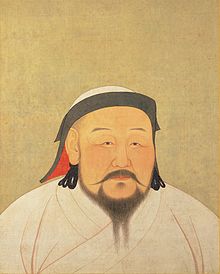 Kublai Khan, the Great Khan of the Mongol Empire and Emperor of the Yuan Dynasty. Painting from 1294.
Kublai Khan, the Great Khan of the Mongol Empire and Emperor of the Yuan Dynasty. Painting from 1294.
In 1260 Kublai was elected as Great Khan of the Mongols and founded the Yuan Dynasty in 1271. The skirmishes of the early 1260s led a major confrontation in Diaoyu, Sichuan in 1265. The Mongolians defeated the Song land and naval armies and captured more than 100 ships.[8]
Kublai did eventually conquer the south, but not without a great deal of tribulation. First there was the war with Ariq Boke, who had been left in command of the north and stationed in the Mongol capital, Karakorum; then in 1268,[9] there was the Mongol advance stopped at the city of Xianyang situated on the Han river controlling access to the Yangtze river, the gateway to Hangzhou (Canton).This city was linked to the city of Fencheng situated on the opposite bank connected by a pontoon bridge spanning the river Han. The walls of Xianyang were some six to seven meters thick encompassing an area of five kilometers wide,the main entrances leading out to a waterway impossible to ford in the summer, in the winter an impassable swamp and series of ponds and mud flats.
The defenders of twin-cities, Xianyang and Fencheng, attempted to break the siege but the Mongols under Aju defeated them each time. The Mongol crushed all reinforcements from the Song, each numbering in thousands.[10] After Aju asked Kublai, the Emperor of the Mongol Empire, the powerful siege machines of the Ilkhanate, Ismail and Al-aud-Din from Iraq arrived South China to construct a new type of trebuchet which used explosive shells. These Persian engineers built mangonels and trebuchets for the siege.[11] Explosive shells had been in use in China for centuries but what was new was the counterweight type of trebuchet as opposed to the torsion type giving greated range and accuracy as it was easier to judge the weight of the counter weight than the torsion generated by repeated windings.[12] The counterweight trebutchet built by the Persians from Mosul were longer in range, and assisted in destroying Fancheng.[13] Chinese and Muslim engineers operated Artillery and siege engines for the Mongol armies.[14] The design was taken from those used by Hulegu to batter down the walls of Baghdad. The Chinese were the first to invent the traction trebuchet, now they faced muslim designed counterweight trebuchets in the Mongol army. The Chinese responded by building their own counterweight trbuchets, an account from the Chinese said "In 1273 the frontier cities had all fallen. But Muslim trebuchets were constructed with new and ingenious improvements, and different kinds became available, far betterthan those used before."[15]
Both the Song and Mongol forces had thunder crash bombs during the siege, a type of gunpowder weapon. the Mongols also utilized siege crossbows and traction trbuchets. The Song forces used fire arrows and fire lances in addition to their own thundercrash bombs. The Song forces also used paddle ships.[16] Siege crossbows and firebombs were also deployed on Song ships against Mongol forces, in addition to fire lances.[17] The name of the bombs in Chinese was Zhen tian lei. They were made from cast iron and filled with gunpowder, the Chinese Song forces delivered them to the enemy via trebuchets. Armor made out of iron could be penetrated by pieces of the bomb after the explosion, which had a 50 kilometer noise range.[18]
Political infighting in the Song also caused the fall of Xiangyang and Fancheng, due to the power of the Lu family, many questioned their alleigance to the Song, The Emperor barred Jia Sidao himself from the command, so Li Tingzhi, an enemy of the Lu family, was appointed commander. Jia permitted the Lu to ignore Li's orders, resulting in a fractitious command. Li was then unable to relieve Xiangyang and Fancheng, managing in only temporary resupply during several breaks in the siege.[19]
Bayan of the Baarin, the Mongol commander, then sent half of his force up river to wade to the south bank in order to build a bridge across to take the Yang lo fortress. Three thousand Song boats came up the Han river and were repulsed; fifty boats destroyed with 2,000 dead. Xianyang's commander then surrendered to the Mongol commander, the entire force including the surrendering commander sailing down the Yangtze, the forts along the way falling as this commander, now allied with the Mongols, had also commanded many of the down river garrisons. In 1270, Kublai ordered the construction of five thousand ships. Three years later, an additional two thousand ships were ordered to be built; these would carry about 50,000 troops to give battle to the Song. In 1273, Fencheng capitulated, the Mongols putting the entire population to the sword to terrorize the inhabitants of Xianyang. After the surrender of the city of Xiangyang, several thousand ships were deployed. The Song fleet, despite their deployment as a coastal defense fleet or Coast Guard more than an operational Navy, was more than a match for the Mongols. Under his great general Bayan Khublai unleashed a riverine attack upon the defended city of Xiangyang on the Han River. The Mongols prevailed, ultimately, but it would take five more years of hard combat to do so.[20] By 1273, the Mongols emerged victorious on the Han River. The Yangtse River was now open for a large fleet that could conquer the Southern Song empire. A year later, the child-prince Zhao Xian was made emperor. Resistance became stiffer, resulting in Bayan's massacre of the inhabitants of Changzhou in 1275 and mass suicide of the defenders at Changsha in January 1276. When the Yuan Mongol-Chinese troops and fleet advanced and one prefecture after the other submitted to the Yuan, Jia Sidao offered his own submission, but the Yuan chancellor Bayan refused. The last contingents of the Song empire were heavily defeated, the old city of Jiankang (Jiangsu) fell, and Jia Sidao was killed. The capital of Song, Lin'an (Hangzhou), was defended by Wen Tianxiang and Zhang Shijie. When Bayan and Dong Wenbing camped outside Lin'an in February 1276, the Song Grand Empress Dowager Xie and Empress Dowager Quan surrendered the underage Emperor Gong of Song along the imperial seal. Emperor Gong abdicated, but faithful loyalists like Zhang Jue, Wen Tianxiang, Zhang Shijie and Lu Xiufu successively enthroned the emperor's younger brothers Zhao Shi and Zhao Bing. Zhao Shi was enthroned as Emperor Duanzong of Song far from the capital in the region of Fuzhou but he died soon afterwards on the flight southwards into modern Guangdong. Zhao Bing was enthroned as Emperor Huaizong of Song on Lantau Island, Hong Kong. On March 19th 1279 the Mongols defeated the last of the Song forces at the naval Battle of Yamen. After the battle, as a last defiant act against the invaders, Lu Xiufu embraced the eight year old emperor and the pair leapt to their deaths from Mount Ya, thus marking the extinction of the Southern Song Dynasty.[21]
Last stand of the Song loyalists (1276-79)
Main article: Battle of Yamen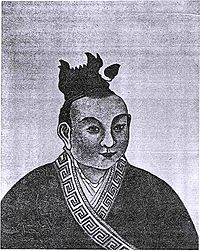 Emperor Bing, the last Song emperor claimant.
Emperor Bing, the last Song emperor claimant.
Empress Dowager Xie had secretly sent the child emperor's two younger brothers to Fuzhou. The strongholds of the Song loyalists fell one by one: Yangzhou in 1276, Chongqing in 1277 and Hezhou in 1279. The loyalists fought the Mongols in the mountainous Fujian–Guangdong–Jiangxi borderland. On February 1279, Wen Tianxiang, one of the Song loyalists, was captured and executed at the Yuan capital Dadu.
The end of the Mongol-Song war occurred on 19 March 1279, when 1000 Song warships faced a fleet of 300 to 700 Yuan Mongol warships at Yamen. The Yuan fleet was commanded by Zhang Hongfan (1238–1280), a northern Chinese, and Li Heng (1236–1285), a Tangut. Catapults as a weapon system were rejected by Kublai's court, for they feared the Song fleet would break out if they used such weapons. Instead, they developed a plan called for a maritime siege, in order to starve the Song into submission.
But at the outset, there was a defect in the Song tactics that would later be exploited by Yuan at the conclusion of the battle. The Song wanted a stronger defensive position, and the Song fleet "roped itself together in a solid mass[,]" in an attempt to create what appears to be in a nautical skirmish line. Results were disastrous: the Chinese could neither attack nor maneuver. Escape was also impossible, for the Song warships lacked any nearby base to which they might take refuge. The course, then, was clear: the Song must stand and fight! Not all the Chinese did, though. On 12 March, a number of Song combatants defected to the Mongol side. On 13 March, a Song squadron attacked some of the Mongols' northern patrol boats. Lorge thinks this action was an attempted breakout, but if so, it failed. The Chinese squadron was crushed with an appalling loss of life. By 17 March, Li Heng and Zhang Hongfan opted for a decisive battle. Four Mongol fleets moved against the Song: Li Heng attacked from the north and northwest; Zhang would proceed from the southwest; the last two fleets attacked from the south and west. Weather favored the Mongols that morning. Heavy fog and rain obscured the approach of Li Heng's dawn attack. The movement of the tide and the southwestern similarly benefited the movement of the Mongol fleet which, in short order, appeared to the north of the Song. It was an unusual attack, in that, the Mongol fleet engaged the Song fleet stern first.
In hindsight, this was a very good tactic. It enabled the naval infantry archers to take full advantage of the ships' high sterncastles. Prior to the battle, the Mongols constructed archery platforms for their sea soldiers. As a result of this simple innovation, the archers atop the sterncastles were transformed into force multipliers against the Song. The position enabled the archers to direct a higher, more concentrated rate of missile fire against the enemy. Fire teams of seven or eight archers manned these platforms, and they proved devastatingly-effective as the battle commenced at close quarter.
Li Heng's first attack cut the Song rope that held the Chinese fleet together. Fighting raged with great intensity at a hand-to hand distance. The Song gave fierce resistance, but by eleven, they had lost three of their ships to the Mongols, though the outcome was still by no means certain. Then, by the forenoon, Li's ships broke through the Song's outer line, and two other Mongol squadrons destroyed the Song formation in the corner of the northwest. Around this time, the tide had shifted; Li's ships drifted to the opposite direction, the north.
The Song believed that the Mongols were halting the attack and, foolishly, dropped their guard. Their mistake was obvious when, suddenly, Zhang Hongfan's fleet, riding the northern current, slammed into the Chinese ships. Zhang was determined to capture the Song admiral, Zuo Tai. The Yuan flagship was protected by shields to negate the Song missile fire. Later, when Zhang did capture the Song flagship, his own vessel was riddled with arrows. Then, as if the Song did not have enough difficulties, Li Heng's fleet returned to the battle. By late afternoon, it was obvious to all observers that the battle was over. The Mongols had prevailed, and the Song navy surrendered.
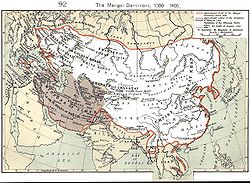 The Mongol Empire included all China. The gray area is the later Timurid empire
The Mongol Empire included all China. The gray area is the later Timurid empire
Horrified, the ruling elite, unwilling to submit to the Mongol rule, opted for death by suicide. The Song councilor, an important post, in that, he was tasked with literally holding the infant child-emperor of the Song in his arms during the battle, also elected to join the Song leaders in death. Not only did he plan his own death, he, or perhaps others, decided to take the infant Emperor to his royal destruction, too. As harsh a decision as this sounds, it is not without its own cruel logic. Presumably, the councilor did not wish to see a mere baby trampled to death in Mongol tradition, as undoubtedly the Yuan would have done to the child-emperor, to leave no doubt that the Song Dynasty was literally dead. Tragically, the councilor jumped into the sea, still holding the child in his arms. Both would die; the Song Dynasty would die with them.; Lorge described the scene and its aftermath: Tens of thousands of Song officials, and women threw themselves into the sea and drowned. The last Song emperor went to the bottom with his entourage, held in the arms of his councilor. With his death, the final remnants of the Song dynasty were eliminated. The victory of this naval campaign marked the completion of Kublai's conquest of China, and the onset of all of China under the Mongol Yuan Dynasty for 97 years until the rise of the Ming Dynasty established under the House of Zhu.
Notes
- ^ C.P.Atwood-Encyclopedia of Mongolia and the Mongol Empire, p.509
- ^ Henry Hoyle Howorth, Ernest George Ravenstein-History of the Mongols, p.228
- ^ John Man-Kublai Khan, p.158
- ^ René Grousset (1970). The Empire of the Steppes: A History of Central Asia (reprint ed.). Rutgers University Press. p. 282. ISBN 0813513049. http://books.google.com/books?id=CHzGvqRbV_IC&pg=PA282&dq=mongols+chinese+general+baghdad&hl=en&ei=IO7hTf_zOITEgAeY3ciRBg&sa=X&oi=book_result&ct=result&resnum=6&ved=0CEIQ6AEwBQ#v=onepage&q=gallant%20meng%20kung%20general%20resistance&f=false. Retrieved 2010-10-28.
- ^ C.P.Atwood-Encyclopedia of Mongolia and the Mongol Empire, p.509
- ^ Jeremiah Curtin-The Mongols A History, p.343
- ^ J.Bor-Mongol hiiged Eurasiin diplomat shastir, vol.II, p.224
- ^ Warren I. Cohen-East Asia at the center: four thousand years of engagement with the world, p.136
- ^ Stephen Turnbull, Wayne Reynolds (2003). Mongol Warrior 1200-1350 (illustrated ed.). Osprey Publishing. p. 8. ISBN 184176583X. http://books.google.com/books?id=KTTELJ9N0XUC&pg=PA64&dq=xiangyang+siege&hl=en&ei=LvXhTYXZFcregQeUnbGuBg&sa=X&oi=book_result&ct=result&resnum=4&ved=0CDgQ6AEwAw#v=onepage&q=xiangyang%20siege%20begins%201268&f=false. Retrieved 2010-10-28.
- ^ John Man-Kublai Khan, p.168
- ^ Jasper Becker (2008). City of heavenly tranquility: Beijing in the history of China (illustrated ed.). Oxford University Press. p. 64. ISBN 0195309979. http://books.google.com/books?ei=5fLhTZSdHZTpgAel0-nHBg&ct=result&id=UOiGAAAAMAAJ&dq=These+siege+engines+could+accurately+lob+huge+missiles+capable+of+demolishing+stone+castles+and+they+quickly+knocked+down+Xianyang%27s+mud+walls&q=xianyang+foreign+engineers+persia+mangonels+catapults. Retrieved 2010-10-28.
- ^ Stephen Turnbull, Steve Noon (2009). Chinese Walled Cities 221 BC-AD 1644 (illustrated ed.). Osprey Publishing. p. 53. ISBN 1846033810. http://books.google.com/books?id=ug_twStv-4sC&pg=PA53&dq=xiangyang+siege&hl=en&ei=fPPhTdCVFYTpgAezoPG_Bg&sa=X&oi=book_result&ct=result&resnum=2&ved=0CC0Q6AEwAQ#v=onepage&q=xiangyang%20siege&f=false. Retrieved 2010-10-28.
- ^ Michael E. Haskew, Christer Joregensen, Eric Niderost, Chris McNab (2008). Fighting techniques of the Oriental world, AD 1200-1860: equipment, combat skills, and tactics (illustrated ed.). Macmillan. p. 190. ISBN 0312386966. http://books.google.com/books?id=1fb7tBwv4ZYC&pg=PA190&dq=xiangyang+siege&hl=en&ei=mfXhTZHVE8idgQfX_ujKBg&sa=X&oi=book_result&ct=result&resnum=9&ved=0CFIQ6AEwCA#v=onepage&q=xiangyang%20siege&f=false. Retrieved 2010-10-28.
- ^ René Grousset (1970). The Empire of the Steppes: A History of Central Asia (reprint ed.). Rutgers University Press. p. 283. ISBN 0813513049. http://books.google.com/books?id=CHzGvqRbV_IC&pg=PA282&dq=mongols+chinese+general+baghdad&hl=en&ei=IO7hTf_zOITEgAeY3ciRBg&sa=X&oi=book_result&ct=result&resnum=6&ved=0CEIQ6AEwBQ#v=snippet&q=chinese%20engines%20artillery%20chinese%20muslim%20engineers&f=false. Retrieved 2010-10-28.
- ^ Stephen R. Turnbull (2003). Genghis Khan & the Mongol conquests, 1190-1400 (illustrated ed.). Osprey Publishing. p. 63. ISBN 1841765236. http://books.google.com/books?id=N2MMD0yfxyAC&pg=PA63&dq=xiangyang+siege&hl=en&ei=ZvnhTaSHMcX30gHg3eiPBw&sa=X&oi=book_result&ct=result&resnum=5&ved=0CD4Q6AEwBA#v=onepage&q=xiangyang%20siege&f=false. Retrieved 2010-10-28.
- ^ Stephen Turnbull (2002). Siege weapons of the Far East: AD 960-1644 (illustrated ed.). Osprey Publishing. p. 12. ISBN 1841763403. http://books.google.com/books?id=0TjxaHltoY0C&pg=PA12&dq=xiangyang+siege&hl=en&ei=DfThTdm6J4OcgQf0oomiBg&sa=X&oi=book_result&ct=result&resnum=3&ved=0CDMQ6AEwAg#v=onepage&q=xiangyang%20siege&f=false. Retrieved 2010-10-28.
- ^ Stephen R. Turnbull (2003). Genghis Khan & the Mongol conquests, 1190-1400 (illustrated ed.). Osprey Publishing. p. 63. ISBN 1841765236. http://books.google.com/books?id=N2MMD0yfxyAC&pg=PA63&dq=xiangyang+siege&hl=en&ei=ZvnhTaSHMcX30gHg3eiPBw&sa=X&oi=book_result&ct=result&resnum=5&ved=0CD4Q6AEwBA#v=onepage&q=xiangyang%20siege&f=false. Retrieved 2010-10-28.
- ^ Matthew Bennett (2008). Matthew Bennett. ed. The Hutchinson dictionary of ancient & medieval warfare. Taylor & Francis. p. 356. ISBN 1579581161. http://books.google.com/books?id=04S4YdDarD0C&pg=PA356&dq=xiangyang+siege&hl=en&ei=afbhTfDHB8Pg0QHOwZ2wBw&sa=X&oi=book_result&ct=result&resnum=8&ved=0CE0Q6AEwBw#v=onepage&q=xiangyang%20siege&f=false. Retrieved 2010-10-28.
- ^ Peter Allan Lorge (2005). War, politics and society in early modern China, 900-1795. Taylor & Francis. p. 84. ISBN 0415316901. http://books.google.com/books?id=t203wZyNqIwC&pg=PA84&dq=xiangyang+siege&hl=en&ei=n_fhTeiPAYLZgQfuxv24Bg&sa=X&oi=book_result&ct=result&resnum=10&ved=0CFkQ6AEwCQ#v=onepage&q=xiangyang%20siege&f=false. Retrieved 2010-10-28.
- ^ Tony Jaques (2007). Tony Jaques. ed. Dictionary of battles and sieges: a guide to 8,500 battles from antiquity through the twenty-first century, Volume 3. Greenwood Publishing Group. p. 1115. ISBN 0313335397. http://books.google.com/books?id=tW_eEVbVxpEC&pg=PA1115&dq=chinese+siege+engines+mongols+xianyang&hl=en&ei=MfLhTfrvGsPW0QHez-iTBw&sa=X&oi=book_result&ct=result&resnum=1&ved=0CCoQ6AEwAA#v=onepage&q&f=false. Retrieved 2010-10-28.
- ^ History of Song
Categories:- Wars involving the Mongols
- Wars involving China
- Song Dynasty
- Yuan Dynasty
- History of Mongolia
- History of China
- Battles of the Song Dynasty
-
Wikimedia Foundation. 2010.

